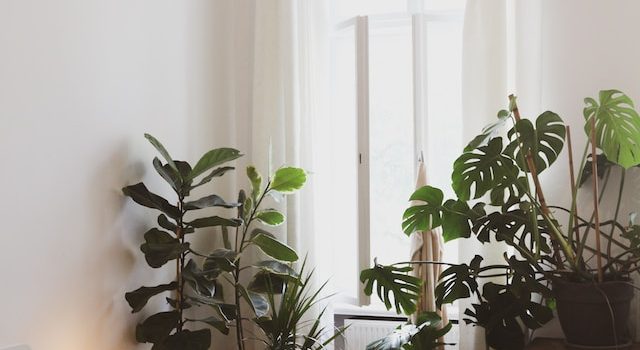
Are you struggling to get a good night’s sleep? Do you wake up feeling exhausted and drained? One of the most important factors that can affect your sleep quality is your environment. And what better way to create a peaceful and relaxing atmosphere in your bedroom than with plants? They not only look great but also have amazing benefits for your health and wellbeing. In this blog post, we’ll show you how to transform your bedroom into a sleep sanctuary with these five plants. So, let’s dive in!
Aloe Vera
Aloe Vera is a succulent plant that has been used for centuries in traditional medicine. It’s packed with antioxidants and anti-inflammatory properties, making it an excellent choice for improving air quality and promoting better sleep.
One of the main benefits of Aloe Vera is its ability to remove toxins from the air. As you sleep, your body repairs itself, but if you’re breathing in polluted air throughout the night, it can hinder this process. That’s where Aloe Vera comes in – it purifies the air by absorbing harmful chemicals like benzene and formaldehyde.
Another benefit of having Aloe Vera in your bedroom is its calming effects. The gel inside its leaves contains amino acids that promote relaxation and reduce stress levels. This can help soothe your mind before bedtime and improve overall sleep quality.
Caring for Aloe Vera is relatively easy too! They prefer bright indirect light and only need watering once every two weeks or so, making them perfect for those who aren’t green thumbs.
Adding an Aloe Vera plant to your bedroom not only adds natural beauty but also provides many health benefits conducive to a good night’s rest!
Lavender
Lavender is a popular plant known for its calming and soothing effects. Its gentle scent has been used in aromatherapy to reduce stress and anxiety, making it the perfect addition to any bedroom.
Aside from its aromatic benefits, Lavender also helps improve sleep quality by promoting relaxation. Studies show that inhaling lavender oil can help increase slow-wave sleep, which is essential for physical recovery and cognitive function.
Growing Lavender indoors requires bright light but avoid direct sunlight as it may burn the leaves. It’s best to keep the soil moist but not too wet as this can lead to root rot. Pruning regularly will encourage new growth and prevent leggy stems.
Adding a pot of Lavender on your nightstand or near your bed can be an excellent way to promote restful sleep naturally. The scent of Lavender before bedtime might just be what you need for a peaceful slumber tonight!
Peace Lily
Peace Lily is a beautiful plant that can transform your bedroom into a sleep sanctuary. It is known for its air-purifying abilities and its ability to reduce stress levels. This plant has glossy green leaves and white flowers that bloom throughout the year.
One of the benefits of Peace Lily is that it can filter toxins such as benzene, formaldehyde, trichloroethylene, xylene, and ammonia from the air. These chemicals are commonly found in household items like carpets, furniture, cleaning products, and paint.
Additionally, Peace Lily can help improve humidity levels in your room by releasing moisture through its leaves. This makes it an ideal plant for those who suffer from dry skin or respiratory problems.
Caring for this plant requires minimal effort as it thrives in low light conditions with little watering needed. However, be sure not to overwater it as this may lead to root rot.
Having a Peace Lily in your bedroom not only adds beauty but also improves the air quality which leads to better sleep.
Snake Plant
The Snake Plant is known for its unique appearance and air-purifying capabilities. It’s a popular choice for those looking to improve the air quality of their bedroom while also adding some greenery.
One interesting fact about the Snake Plant is that it can survive in low light conditions, making it an excellent option for bedrooms with limited natural light. Plus, they only need watering once every two weeks, so they’re perfect for those who want to add plants to their sleep sanctuary without committing too much time or effort.
Another benefit of having a Snake Plant in your bedroom is that it can help regulate humidity levels. This plant releases oxygen at night and absorbs carbon dioxide during the day, which makes them ideal for improving indoor air quality while you sleep.
In addition to their practical benefits, Snake Plants are also visually appealing with long, upright leaves that resemble snakes (hence the name). They come in various shades of green and even have variegated patterns on their leaves.
If you’re looking for an easy-to-care-for plant that helps purify your bedroom’s air and adds a touch of visual interest, consider adding a Snake Plant to your sleep sanctuary.
Golden Pothos
Golden Pothos, also known as Devil’s Ivy, is a popular houseplant that can add an elegant touch to your bedroom. This plant features heart-shaped leaves with yellow and green variegation that can brighten up any space.
One of the best things about Golden Pothos is how easy it is to care for. It thrives in low to medium light conditions, making it perfect for bedrooms with limited natural sunlight. You only need to water it when the soil becomes dry to the touch.
Aside from its aesthetic appeal and low maintenance requirements, Golden Pothos has several benefits that make it an excellent addition to your sleep sanctuary. It purifies the air by removing harmful toxins such as formaldehyde and benzene commonly found in household products.
Moreover, having plants like Golden Pothos in your bedroom can help reduce stress levels and promote better sleep quality. Studies have shown that being around nature or indoor plants can have a positive impact on mental health.
Adding a Golden Pothos plant to your bedroom not only enhances its visual appeal but also creates a healthier environment where you can rest peacefully.
How to Care for Your Plants
Caring for your plants is essential to ensure they thrive and contribute to creating a peaceful sleeping environment. Here are some tips on how to take care of the 5 plants mentioned earlier.
Aloe Vera:
This plant requires bright indirect sunlight and well-draining soil. Water it when the top inch of soil is dry, but be careful not to overwater as this can cause root rot.
Lavender:
Lavender needs a sunny spot with well-draining soil. Water it when the soil feels slightly dry. To encourage bushiness, pinch back stems after flowering.
Peace Lily:
Peace lilies prefer low light conditions and moist but not waterlogged soil. Water once a week or when you see drooping leaves – this is usually an indication that it needs watering.
Snake Plant:
The snake plant thrives in low light conditions and prefers infrequent watering – allow the soil to dry out completely between watering sessions.
Golden Pothos:
This fast-growing vine likes bright, indirect light or partial shade. Allow the top inch of its potting mix to dry before watering again; excessive moisture can cause yellowing leaves.
By following these simple guidelines, you’ll help your sleep sanctuary plants grow healthy while enhancing your bedroom’s overall atmosphere!
Conclusion
Having a good night’s sleep is essential for our physical and mental well-being. Our bedroom environment plays a significant role in achieving that goal, and incorporating plants into it is an excellent way to boost the ambiance of your sleeping area.
In this article, we have discussed five plants that can help transform your bedroom into a sleep sanctuary: Aloe Vera, Lavender, Peace Lily, Snake Plant, and Golden Pothos. Each one of them has unique qualities that make them ideal for promoting better sleep quality.
Remember always to consider factors such as lighting conditions and watering frequency when caring for your plants. With proper care and attention given to these green companions, you’ll reap the benefits of their ability to purify the air while creating a relaxing atmosphere in your room.
So why not try adding some indoor foliage to your bedroom? It may just be what you need for better restful nights!










